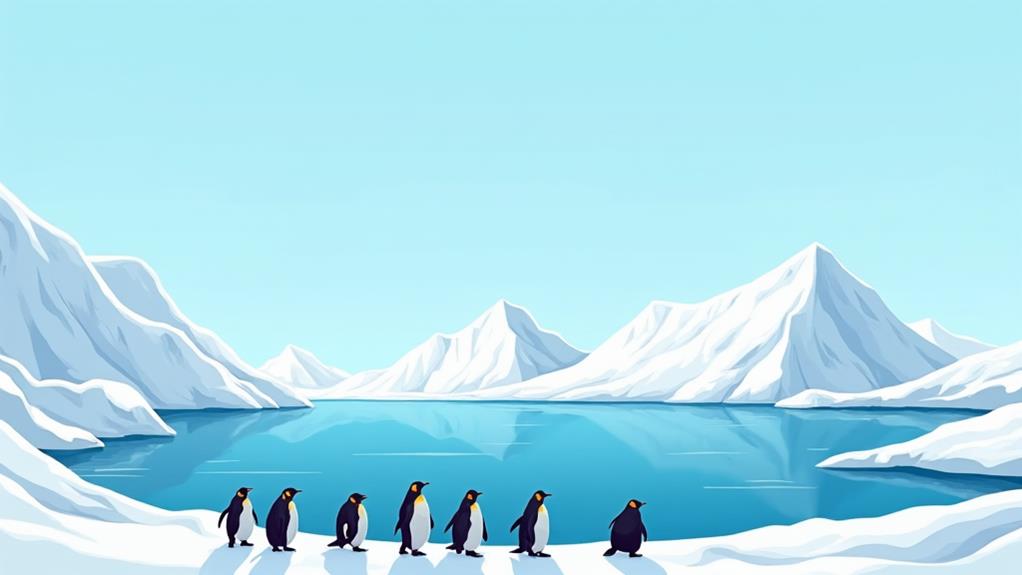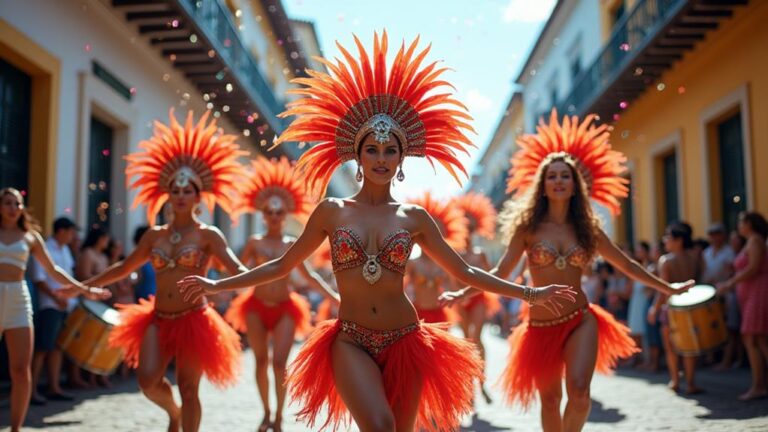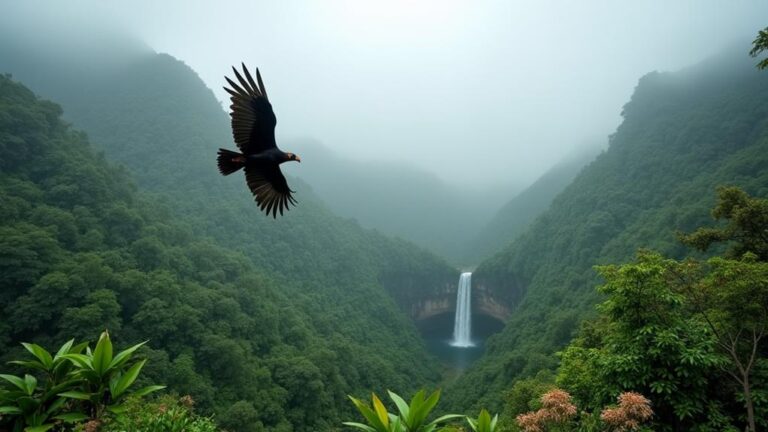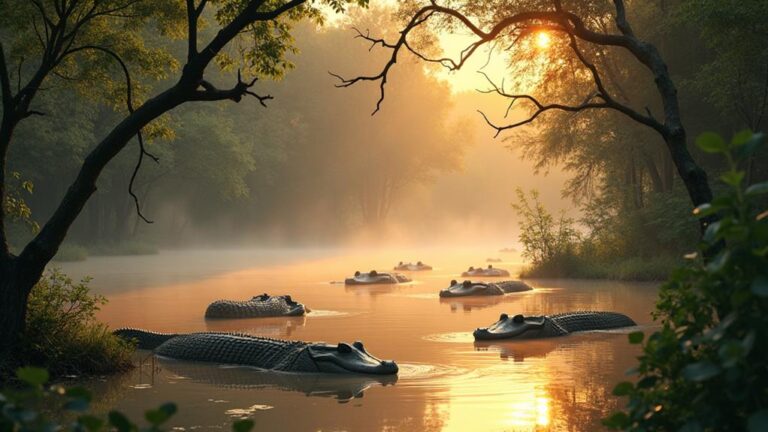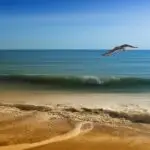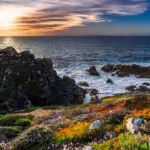You might be surprised to learn that Antarctica has a "rush hour" of sorts, where certain areas become congested with tourists during the peak season. But what drives this influx of visitors, and how can you navigate the crowds to experience the continent's unparalleled beauty? The answer lies in understanding the seasonal variations that shape Antarctica's landscape, wildlife, and accessibility. As you plan your trip, you'll want to ponder the trade-offs between balmy weather, unique research opportunities, and solitude – and that's just the beginning.
Contents
Key Takeaways
- Summer (December to February) offers ideal weather conditions, longest daylight hours, and breathtaking landscapes for outdoor enthusiasts.
- Winter (June to August) is ideal for those seeking solitude, unique wildlife behavior, and lower travel costs.
- Spring (September to November) and Autumn (March to May) provide vibrant wildflowers, penguins' molting process, and stunning photographs.
- The best time for cruising Antarctica is during the Austral spring and summer (November to March) due to mild weather and accessible routes.
- Each season offers unique experiences, so choose based on your interests, preferences, and what you want to see and do in Antarctica.
Summer: The Peak Tourist Season
During the Austral summer, from November to March, Antarctica transforms into a prime tourist destination, beckoning adventurers like you to experience the frozen continent in all its glory.
This period offers the best weather conditions, with temperatures ranging from 23°F to 32°F (-5°C to 0°C), making it ideal for outdoor activities like hiking, kayaking, and camping.
The summer solstice, which falls on December 21 or 22, marks the longest day of the year, with up to 20 hours of daylight.
These Midsummer days provide ample opportunities to explore Antarctica's breathtaking landscapes, including majestic glaciers, towering icebergs, and picturesque research stations.
You'll have plenty of time to take in the sights and sounds of this unforgiving yet awe-inspiring environment.
With the sun shining brightly, you'll be able to capture stunning photographs and make unforgettable memories.
Winter: The Off-Season Advantage
As you plan your trip to Antarctica during the winter months, you'll find that you're not alone, but you're certainly not surrounded either – the off-season brings fewer tourists to this frozen landscape.
With lower travel costs, you'll have more financial freedom to customize your adventure. And, as you explore this winter wonderland, you'll be treated to unique wildlife behavior that's only visible during this time of year.
Fewer Tourists Around
Only about 1,000 tourists venture to Antarctica during the winter months, a significant drop from the 5,000 who visit during the peak season.
This drastic decrease in visitors means you'll have the opportunity to experience the continent in a more serene and peaceful state.
As a solitude seeker, you'll appreciate the quiet, unspoiled landscapes that seem to stretch on forever.
Imagine having the following experiences all to yourself:
- Watching a pod of orcas breach in the icy waters without the distraction of other tourists
- Trekking across the snow-covered terrain, your footsteps the only sound in the stillness
- Standing at the edge of a frozen lake, the only ripples on the water coming from the wind
You'll feel like you have the entire continent to yourself, free to explore and discover its secrets at your own pace.
The peaceful landscapes will be yours to absorb, without the noise and chaos that often comes with peak tourist season.
Lower Travel Costs
Beyond the serene landscapes and peaceful atmosphere, traveling to Antarctica during the winter months also offers a substantial advantage when it comes to your wallet. You'll be pleased to know that traveling during the off-season can notably reduce your travel costs.
| Type of Cost | Off-Season Savings |
|---|---|
| Flights | Up to 30% cheaper with budget airlines |
| Accommodation | Discounted rates at research stations and campsites |
| Cruises | Special off-season deals on select itineraries |
| Guided Tours | Lower prices for guided excursions and activities |
| Equipment Rentals | Reduced rates for essential gear and equipment |
Unique Wildlife Behavior
Your journey to Antarctica during the winter months offers a unique opportunity to observe wildlife behavior that's distinct from the summer season.
The harsh, cold climate brings out fascinating adaptations in the continent's incredible creatures.
You'll witness mating rituals that are more intense and dramatic, as species fight for survival in the harsh environment.
- Penguins form large colonies, huddled together for warmth, as they take turns incubating eggs and hunting for food.
- Seals and sea lions engage in feeding frenzies, gorging on krill and fish to build up fat reserves before the long, dark winter.
- Whales, such as humpbacks and minke, migrate to the Antarctic waters to feast on the abundant krill, their haunting songs echoing through the frozen landscape.
Winter's challenges bring out the resilience and resourcefulness of Antarctica's wildlife, and you'll have a front-row seat to this incredible spectacle.
Spring: Wildlife and Landscapes
As you explore Antarctica in the spring, you'll be surrounded by vibrant wildflowers that burst into bloom, painting the landscape with colorful hues.
This season also marks the beginning of the penguins' molting process, where they shed their old feathers and grow new ones, a fascinating spectacle to witness.
With the sun shining brighter and longer, you'll have ample opportunities to capture stunning photographs of this unique and breathtaking scenery.
Blooming Wildflowers Abound Here
Explore Antarctica's frozen tundra during spring, and you'll be greeted by a surprising splash of color: blooming wildflowers.
This Floral Spectacle is a rare treat, as the harsh climate and short growing season make it challenging for plants to thrive.
Yet, in the brief window of spring, the Arctic Oasis comes alive with vibrant hues.
As you wander through the frozen landscape, you'll spot:
- Delicate Antarctic hair grass, its feathery plumes swaying gently in the breeze
- Bright yellow Antarctic pearlwort, its tiny flowers shining like miniature suns
- Crimson Antarctic gentian, its trumpet-shaped blooms adding a pop of color to the monochrome terrain
These hardy wildflowers have adapted to the extreme conditions, and their resilience is a tribute to the power of life in one of the most inhospitable environments on Earth.
Take a moment to appreciate the beauty of this fleeting spectacle, and you'll be rewarded with an unforgettable experience.
Penguins Start to Molt
Spring's thaw brings a peculiar phenomenon to Antarctica's frozen shores: penguins start to molt.
As you explore the frozen landscape, you'll notice penguins going through an awkward phase, shedding their old feathers and replacing them with new ones.
This process, known as molting, is vital for their survival, as it allows them to maintain waterproof feathers that keep them insulated in the harsh Antarctic climate.
You'll observe distinct molting patterns among different penguin species.
Some, like the Adelie penguins, molt all at once, leaving them vulnerable and flightless for a short period.
Others, like the Emperor penguins, molt gradually, replacing feathers one by one to minimize disruption to their daily activities.
As you witness this unique spectacle, you'll gain a deeper appreciation for the remarkable adaptations that enable penguins to thrive in this unforgiving environment.
The process of feather replacement is an indicator to their remarkable resilience, and a reminder of the importance of preserving this fragile ecosystem.
Autumn: Shoulder Season Benefits
During the autumn months, you'll find Antarctica in a state of metamorphosis, with winter's chill slowly creeping in, yet the sun still shining bright.
This shoulder season offers a unique blend of benefits that make it an attractive time to visit.
As the crowds dissipate, you'll experience *Autumn solitude*, allowing you to fully immerse yourself in the surreal landscapes.
The scenery transforms into a kaleidoscope of colors, with the snow-capped mountains, glaciers, and frozen tundras taking on a golden hue.
Some of the perks of visiting during autumn include:
- Fewer tourists: You'll have a more intimate experience, with fewer people vying for space on excursions and at scenic viewpoints.
- Lower prices: Take advantage of discounted rates on cruises and tour packages.
- Unparalleled photography opportunities: The soft, golden light and dramatic landscapes create a photographer's paradise, perfect for capturing *Autumn landscapes* that will leave you breathless.
Best Time for Wildlife Viewing
As you venture into Antarctica's autumn, you'll stumble upon a wildlife wonderland. During this period, from March to May, the continent's wildlife is at its most active. The combination of warmer temperatures and abundant food sources creates an ideal environment for wildlife viewing. Sea bird colonies, such as penguins and petrels, thrive as they prepare for the breeding season.
| Species | Best Time to See |
|---|---|
| Penguins | March to May, during breeding season |
| Whales | April to May, as they migrate to the coast |
| Seals | March to April, as they haul out on ice floes |
| Petrels | March to May, as they nest on rocky outcrops |
The Krill blooms, which occur during autumn, attract an array of marine life, including whales, seals, and sea birds. Take advantage of this unique opportunity to witness the fascinating interactions between these species. As you explore Antarctica's autumn, be prepared for unforgettable wildlife encounters that will leave you in awe.
Best Time for Cruising Antarctica
You've experienced the thrill of witnessing Antarctica's wildlife in its element, now it's time to focus on the best time to cruise this unforgiving yet majestic landscape.
When it comes to cruising Antarctica, timing is everything. The best time for cruising is during the Austral spring and summer, from November to March.
This period offers the best combination of weather, sea ice, and access to remote areas.
Here's what you can expect during this time:
- Mild weather: Temperatures range from 25°F to 40°F (-4°C to 4°C), making it ideal for cruising.
- Accessible routes: The sea ice has melted, allowing ships to navigate through narrow channels and reach remote areas.
- Enhanced ship amenities: Longer days and better weather enable ships to offer more activities, such as kayaking, camping, and mountaineering.
With cruise durations ranging from 10 to 20 days, you'll have ample time to take in the breathtaking scenery and enjoy the ship's amenities.
Keep in mind that the best time for cruising Antarctica also means higher prices, so plan ahead and book early to secure your spot.
Planning Around the Austral Summer
By the time you set foot on the Antarctic Peninsula, the Austral summer is in full swing, and the landscape is teeming with life.
As you plan your trip, consider the climate considerations that come with this season. The warmer temperatures, ranging from 23°F to 32°F (-5°C to 0°C), make it ideal for outdoor activities like kayaking, camping, and mountaineering.
However, the increased precipitation and strong winds demand careful packing and preparation.
The Austral summer also presents unique research opportunities.
Scientists flock to Antarctica during this time to study the continent's wildlife, including penguins, seals, and whales, which are more active and abundant during the summer months.
You may have the chance to participate in citizen science projects or join expeditions led by experienced researchers.
Take advantage of the extended daylight hours to explore the Antarctic wilderness and make the most of your trip.
With proper planning and preparation, the Austral summer can be an unforgettable experience.
Frequently Asked Questions
Can I Take a Trip to Antarctica on a Budget?
You can explore Antarctica on a budget by booking budget cruises, which often offer shared cabins and basic amenities, and snagging economical flights to Ushuaia or Punta Arenas, the departure points for most Antarctic expeditions.
Are There Any Age Restrictions for Antarctica Travel?
You'll find no specific age restrictions for Antarctica travel, but senior travelers may need to provide medical clearance, while youth expeditions cater to 18-30-year-olds, offering a unique chance for young adventurers to explore the continent.
Can I Go to Antarctica With a Physical Disability?
You'll be thrilled to know that, with some extra planning, you can set out on an Antarctic adventure despite physical limitations. Look for accessible cruises offering disability support, ensuring a safe and enjoyable journey to the icy continent.
Are There Any Solo Travel Antarctica Tour Options?
You'll find several solo travel Antarctica tour options catering to solo travelers, including female explorers, offering a range of itineraries and activities, such as kayaking, camping, and mountaineering, ensuring an unforgettable adventure in this unforgiving yet breathtaking landscape.
Do I Need Special Vaccinations to Visit Antarctica?
You'll need to tackle two vital steps before setting out on your Antarctic adventure: obtaining necessary vaccine requirements, such as Hepatitis A and B, and securing medical clearance to guarantee you're fit for the extreme environment.
Conclusion
You've made it to the end of this Antarctic adventure, but the real question is: are you ready to set out on the journey of a lifetime? The clock is ticking, and the icy landscape awaits. Will you brave the peak tourist season, revel in the off-season's solitude, or seize the shoulder season's benefits? The choice is yours, but one thing's for sure – Antarctica is calling, and you won't want to miss it.

